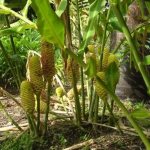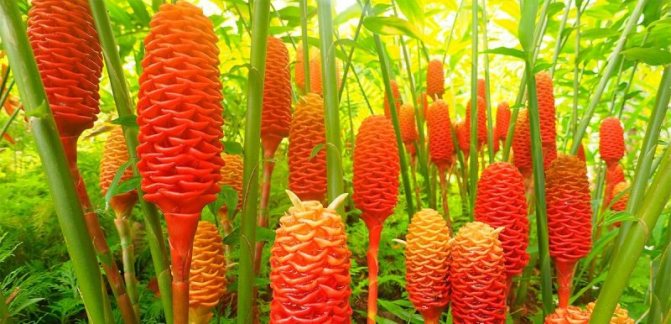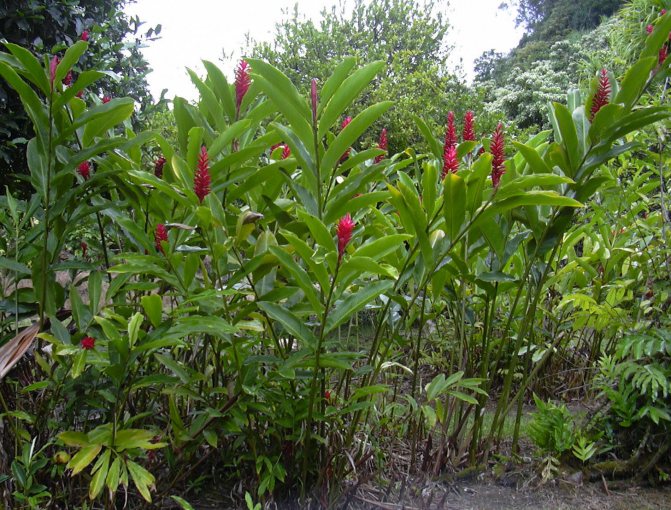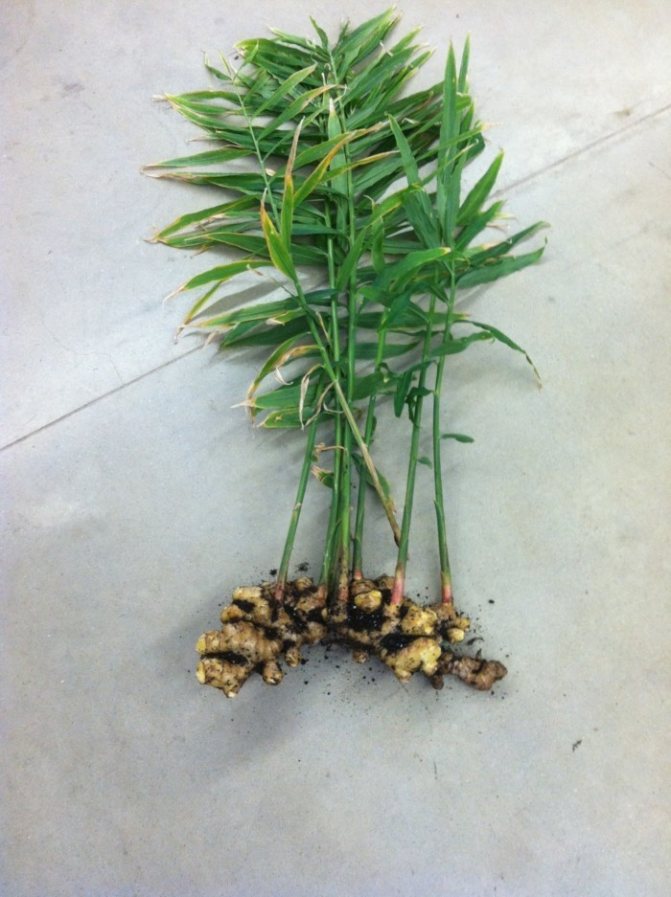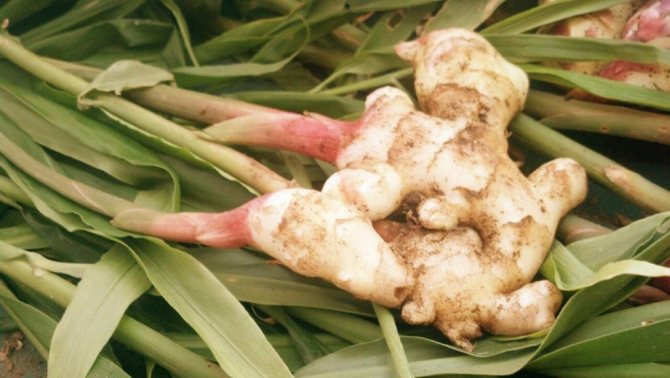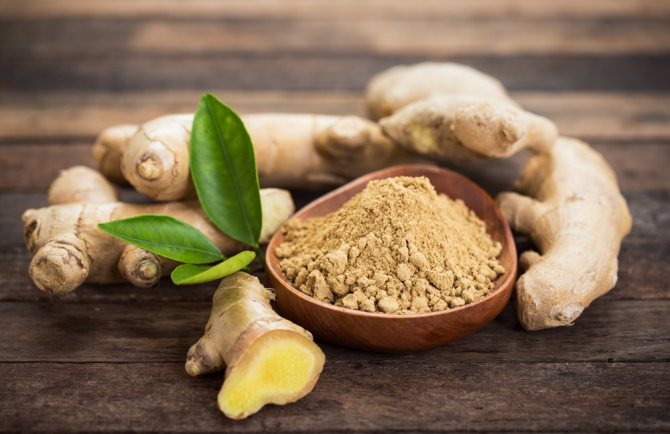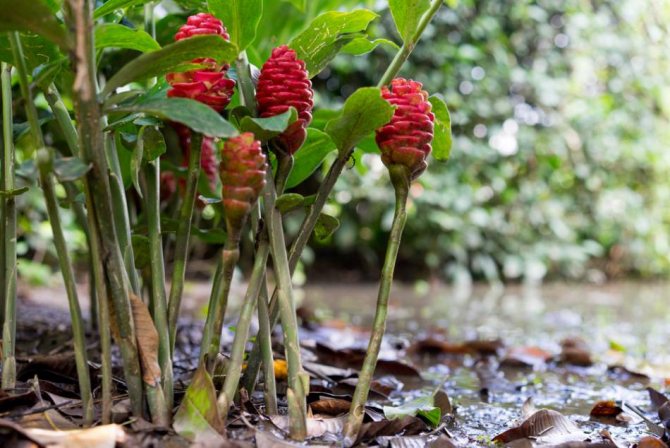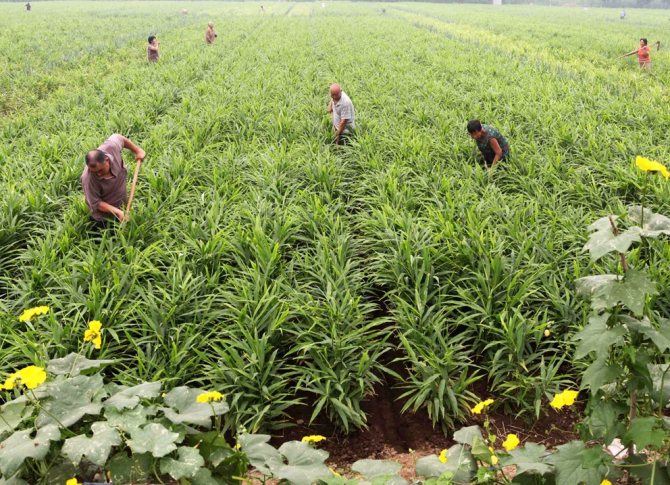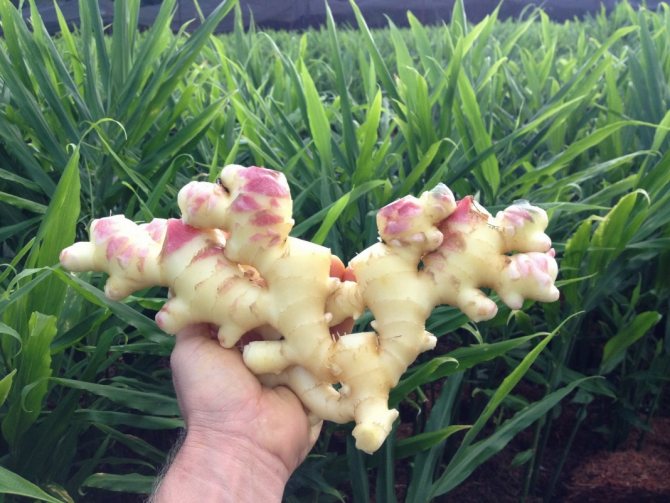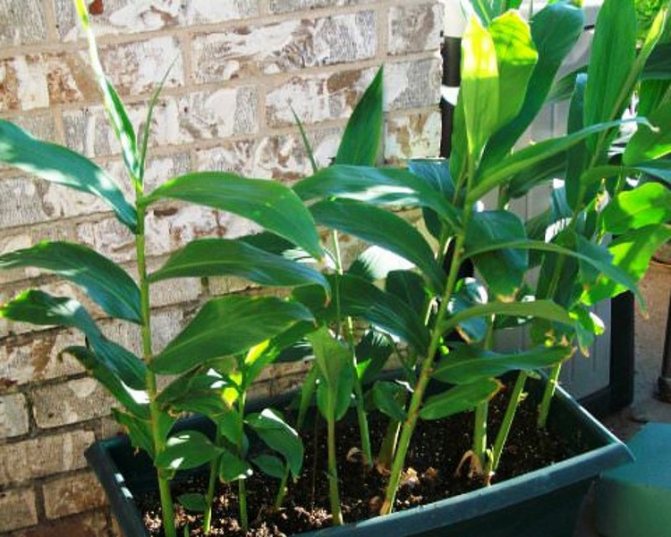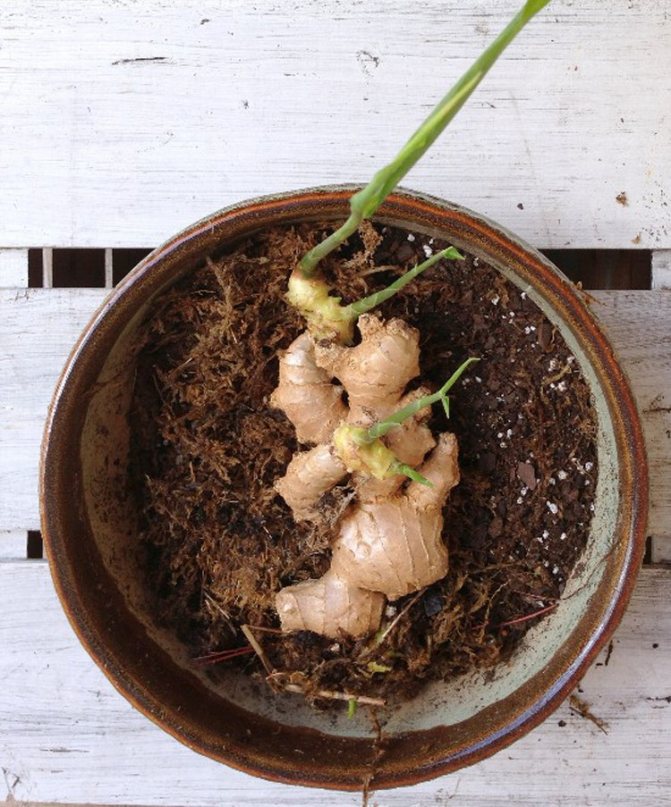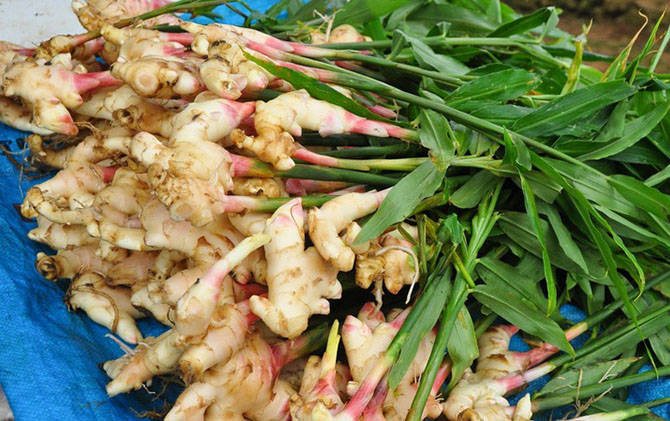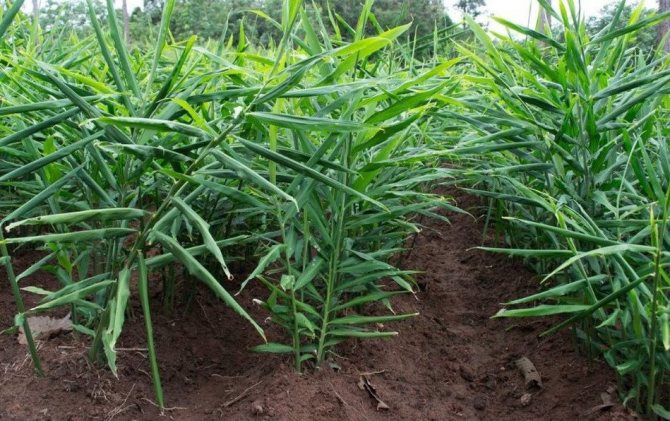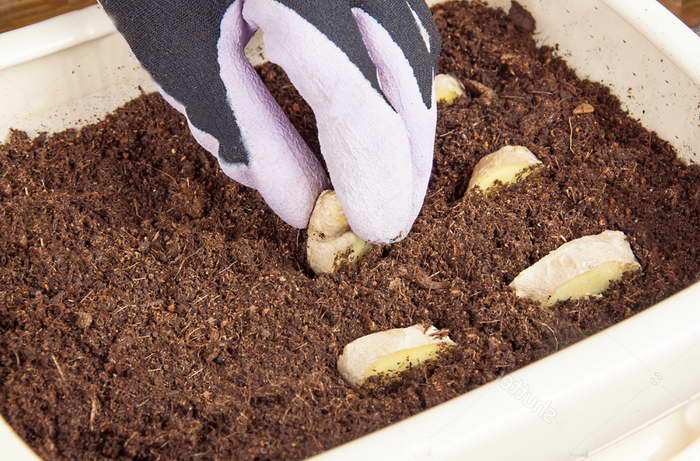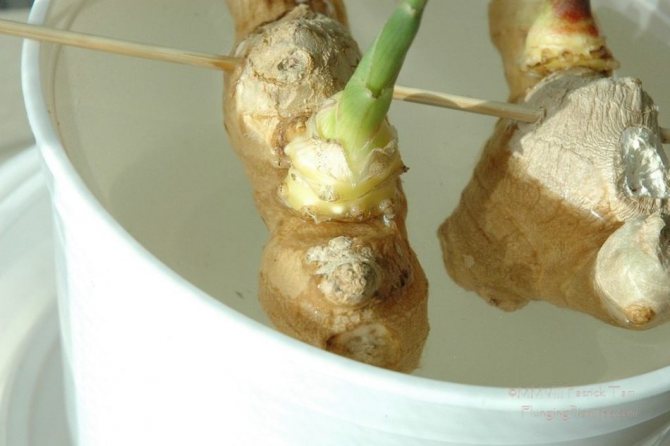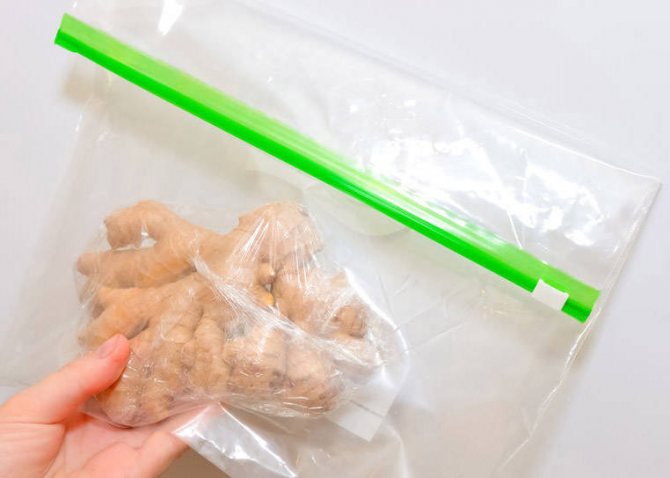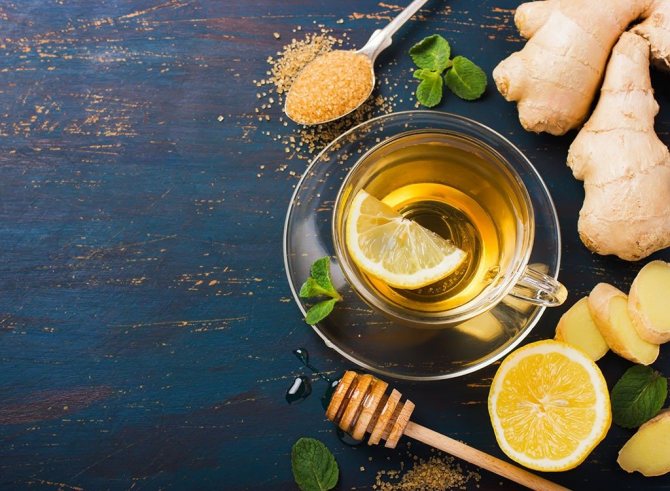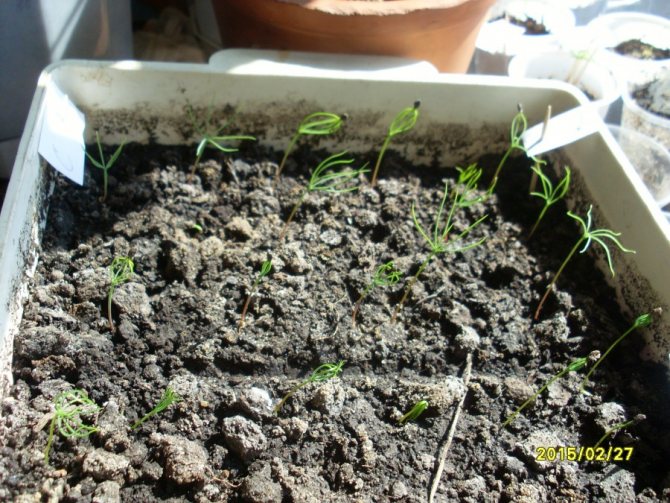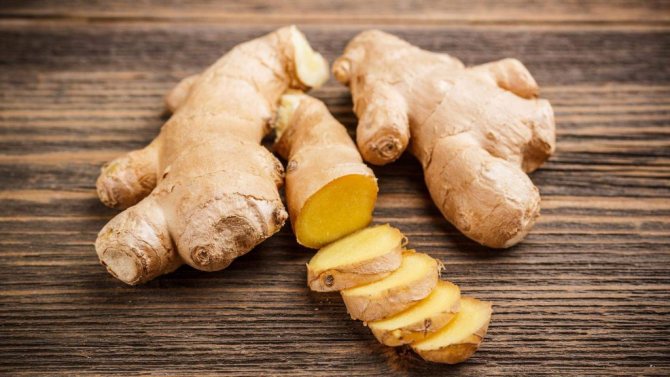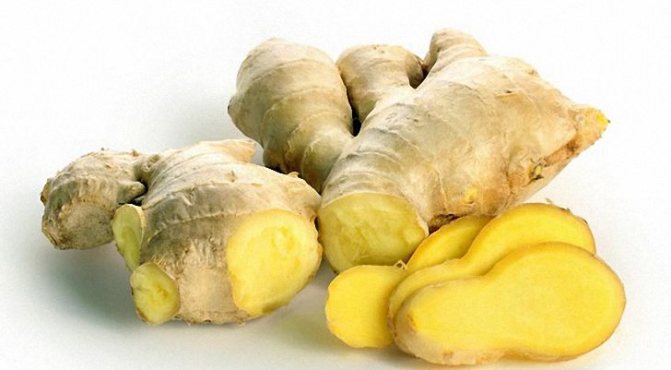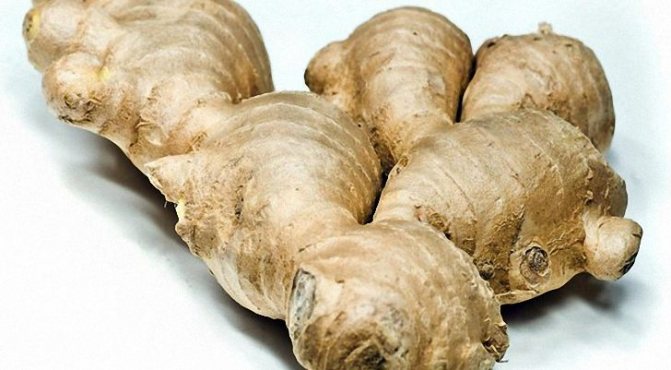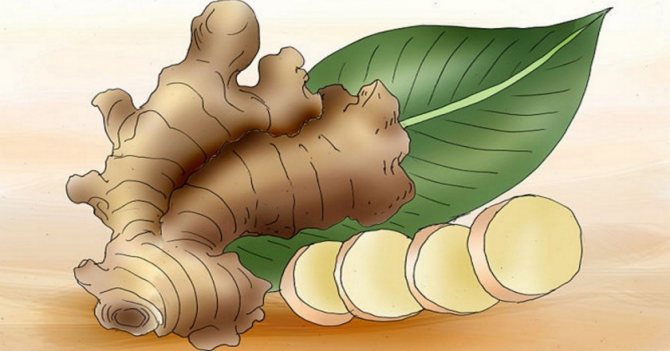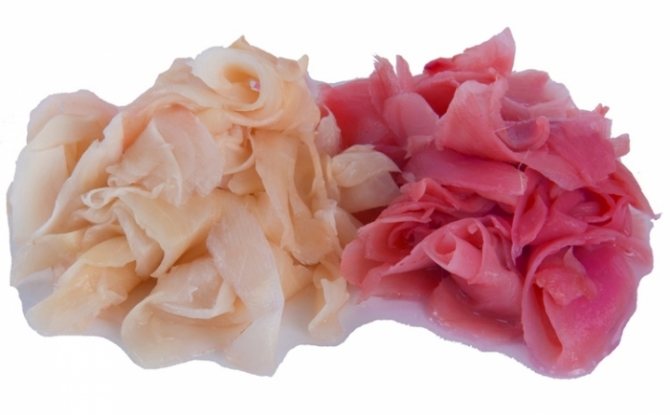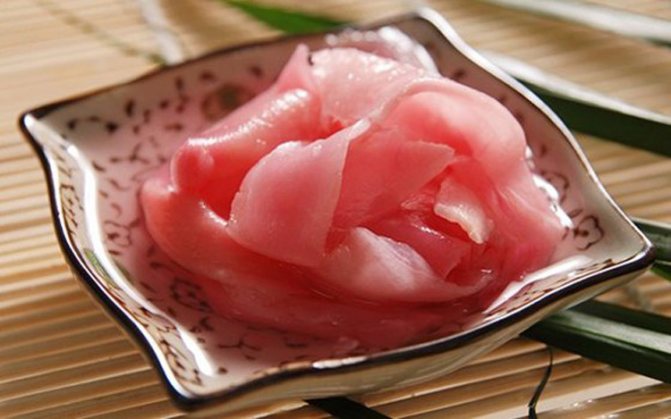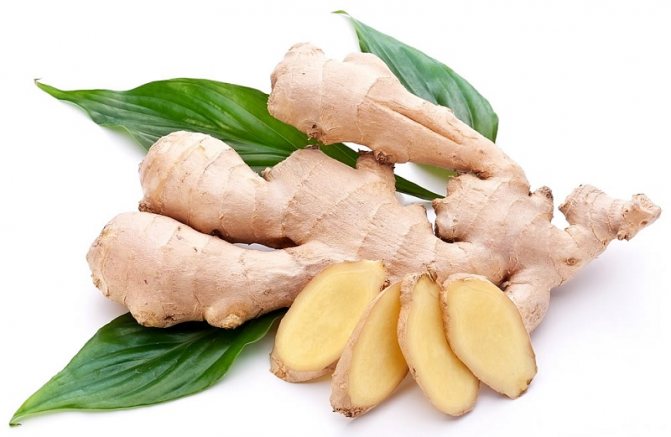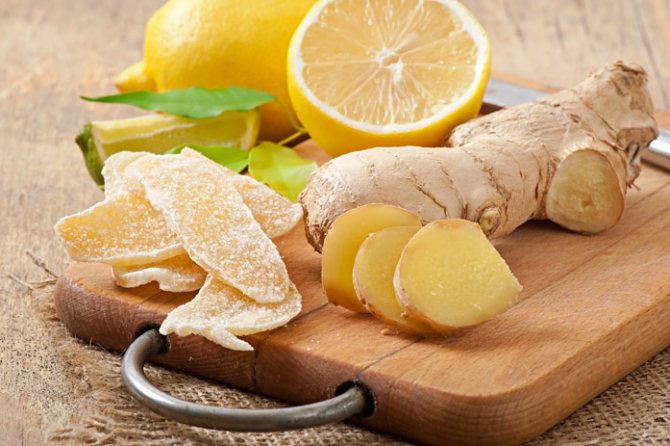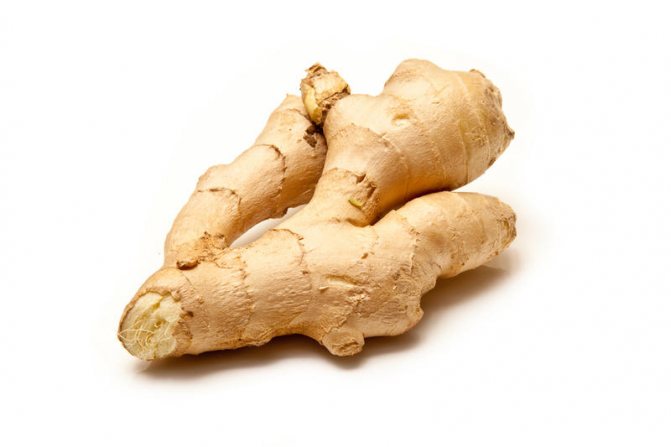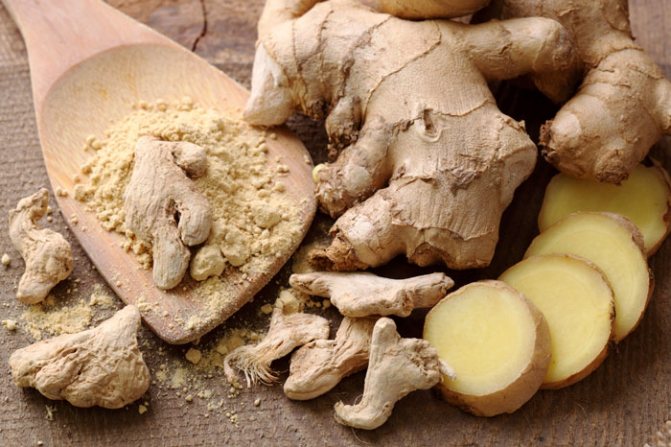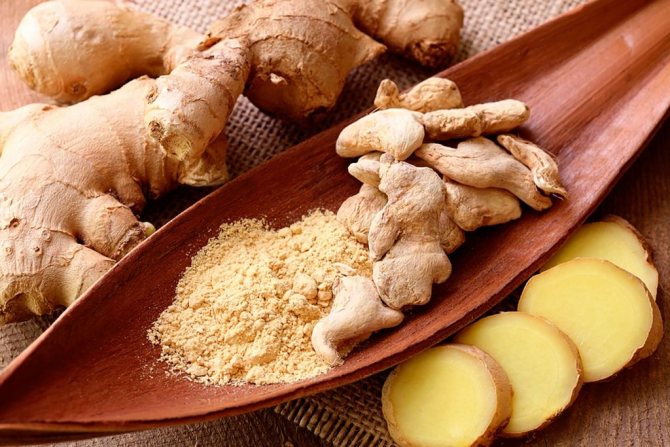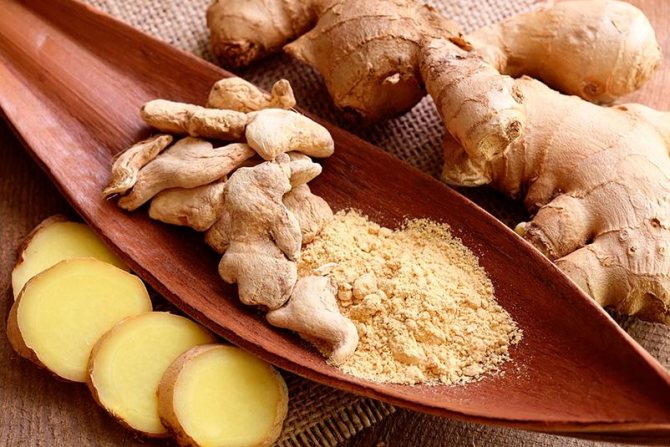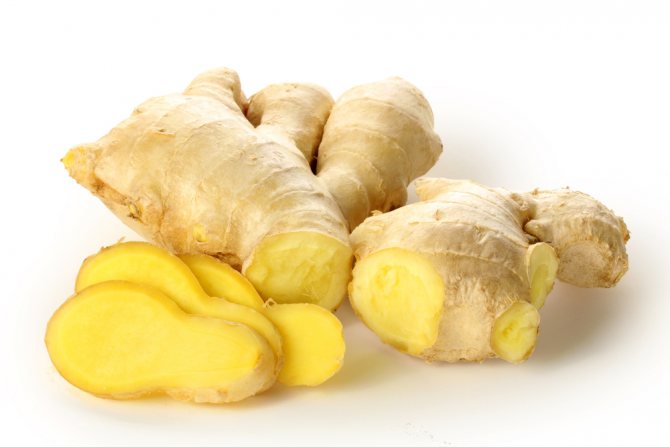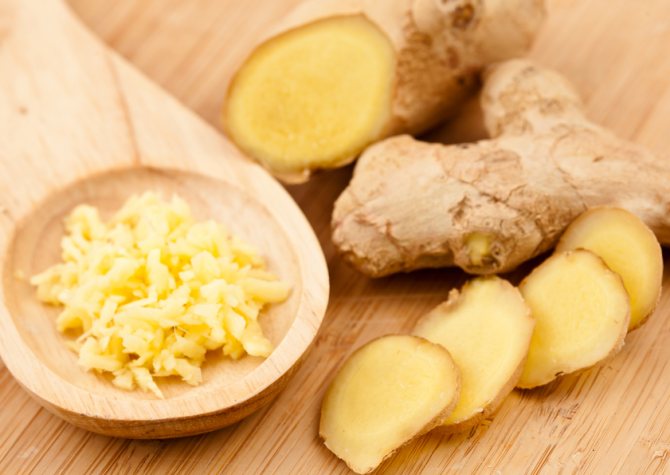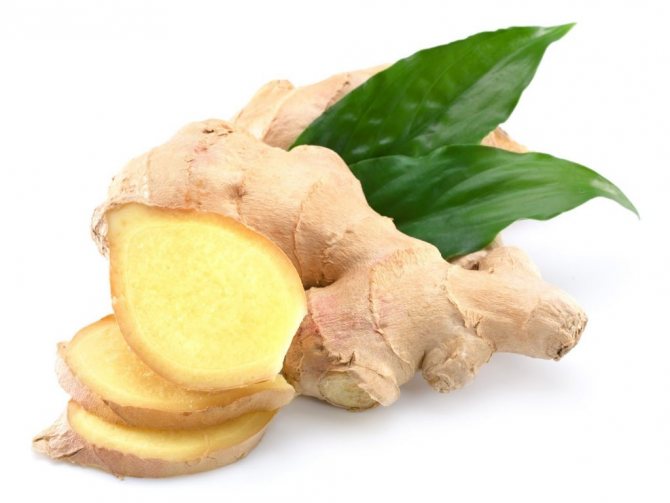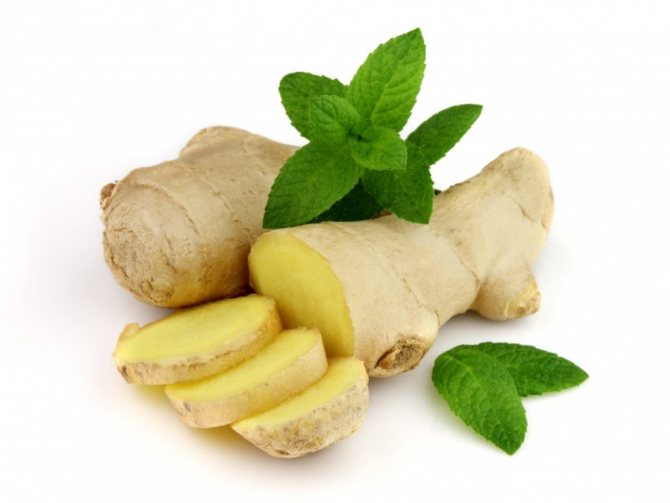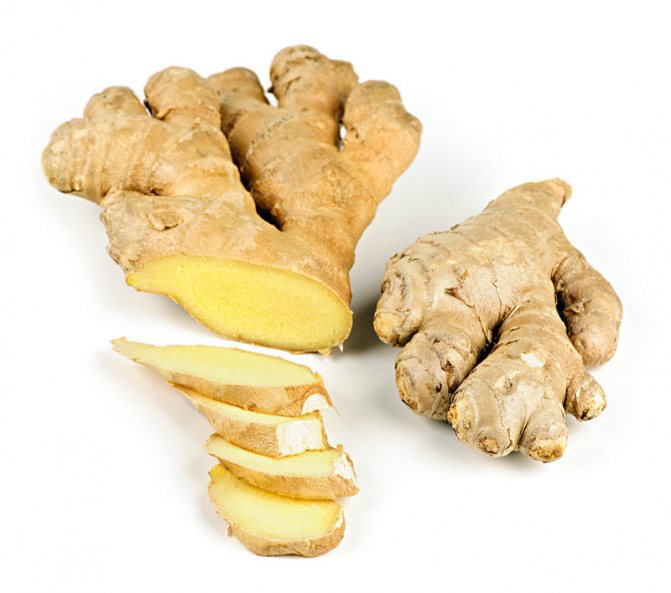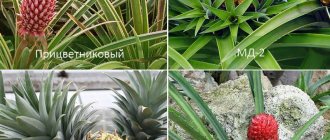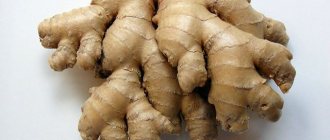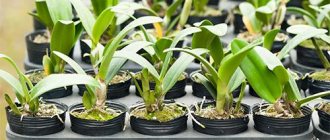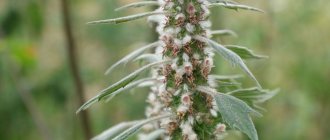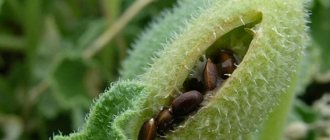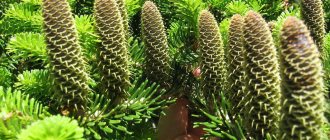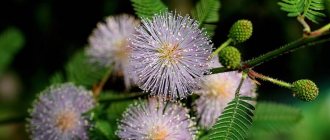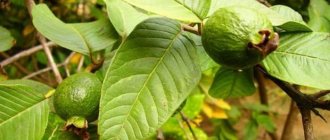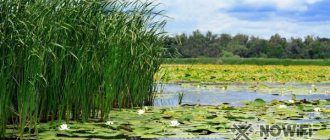How to grow ginger at home?
Ginger is an ancient cultivated plant. So ancient that there is no information about how ginger grows in nature, since its wild ancestors are gone. The first mentions of its use are found in ancient written sources, which are over 2000 years old.
Merchants brought it to the European continent from India and presented it as a universal medicine. The Greeks, who were the first to recognize the taste of this root, spread its use to other countries.
There is a similar article on this topic - Milk thistle: medicinal properties, benefits and harms.
It is believed that the famous traveler Marco Polo brought ginger to medieval Europe in 1270. The taste and healing properties of ginger were appreciated, it has been used throughout Europe since the 15th century.
In eastern countries, and especially in China, ginger root has been used since ancient times and is still considered miraculous. From the works of ancient scientists and healers, you can find out what are the beneficial properties of ginger.
Russian people have known this seasoning since the times of Kievan Rus. The root was brought by merchants from overseas countries along with other spices. Ginger root was added to kvass, mash, sbiten, liqueur. It was also added to pastry for cakes and rolls. From those ancient times, the name of the confectionery remained - gingerbread. The gingerbread root was added to the gingerbread dough, which made their taste especially memorable.
In post-revolutionary Russia, ginger was a little-known exotic. And only quite recently these wonderful miraculous roots appeared on the shelves of Russian vegetable stores.
Where does ginger grow?
Ginger (lat. - Zingibe) is a perennial herb of the ginger family. Outwardly, it looks like a grassy palm, with erect, scaly stems and long, pointed leaves. In natural habitats (India, China, West Africa, Australia), plants can grow up to two meters in height.
The peculiarity of ginger is that, being a flowering plant, it does not bear fruit even under natural conditions.
Different plant varieties give different colors to the spike-shaped inflorescences located on the tops of the shoots and in the leaf axils. The most common colors are yellow, brown, greenish yellow, red, purple.
Ginger is propagated by the rhizome, which is highly developed. It is thick and dense, covered with several layers of leaves and internodes, in which the adventitious roots are located. The ripening of a culture is determined by the leaves that begin to fall off.
How does ginger grow? Video:
Main varieties
Mainly two varieties of ginger root are grown, which can be found on the shelves of vegetable stores:
- Black ginger, or Barbados, with a sharp, pungent taste and rich aroma. Its rhizomes are not cleaned, but scalded with boiling water;
- White ginger, or Bengal, which is more often represented on the Russian market. Its taste is more in line with Russian cuisine, as it is less pungent than the black root. White ginger undergoes additional treatment with sulfurous acid.
What does ginger look like, photo:
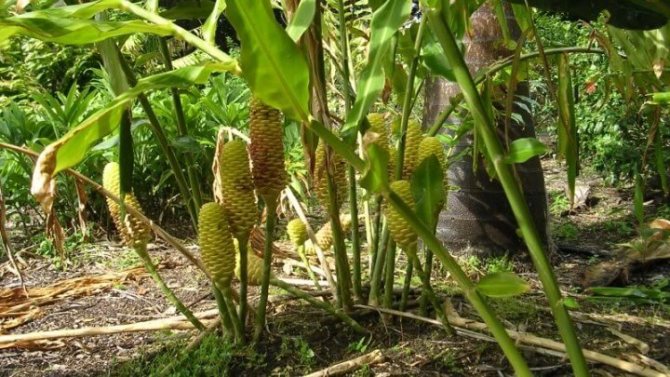
how does ginger grow?
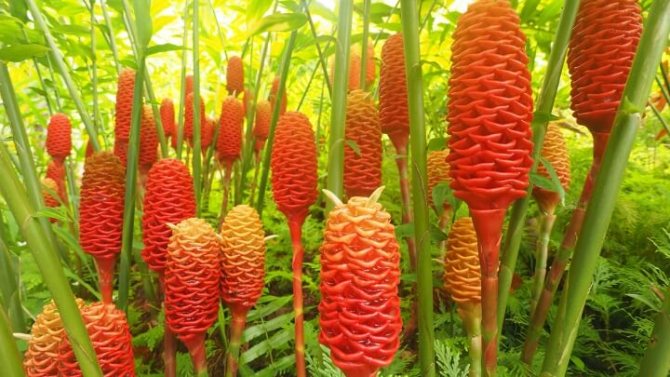

photo of ginger plant
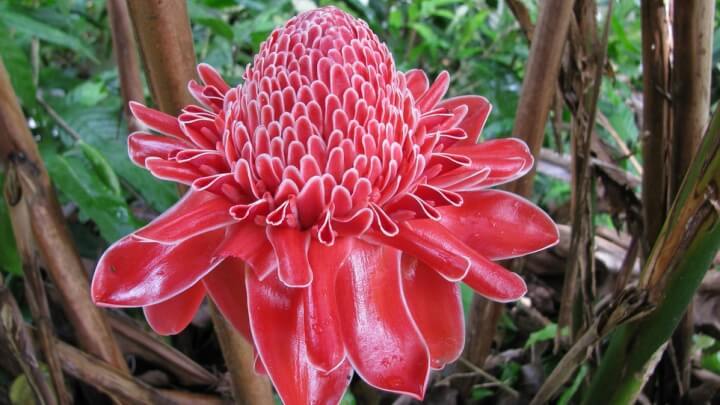

How does ginger bloom? Flower photo


photo: growing ginger on an industrial scale
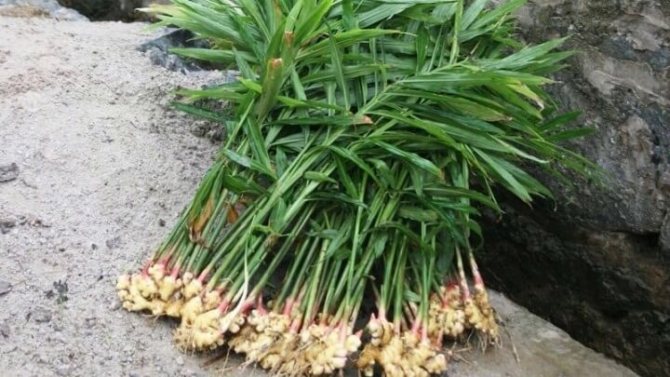

this is how the harvested ginger looks like
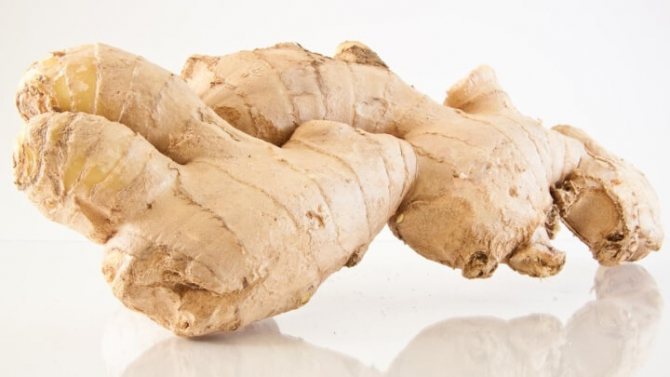

photo of ginger root. The one that we eat and for medicinal purposes
Growing ginger root at home
Where does ginger grow in Russia in the open field, in natural conditions? The most suitable conditions for this are - subtropics of Russia... This is a narrow strip of the Black Sea coast of Russia and Crimea. In subtropical conditions, many southern plants have the possibility of a year-round growing season, which is a prerequisite for the growth of ginger.
How to grow ginger at home? In a temperate climate in Russia, it can be grown in a greenhouse, first germinating in pots at room temperature.
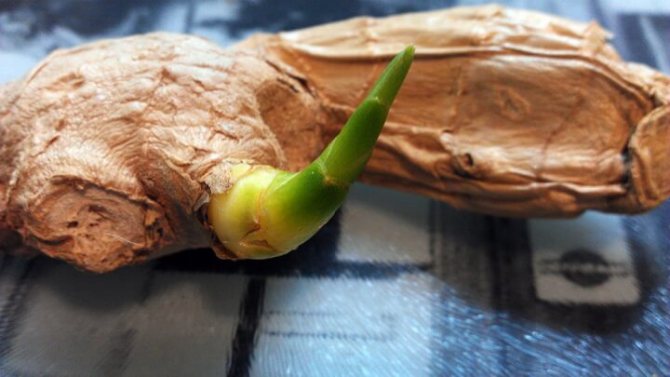

The purchased ginger root should be cut into pieces so that each of them has live buds. Drainage should be placed at the bottom of the pot, in the form of fine gravel and sand. Then, sprinkle nutritious potting soil over it. The depth of the root is shallow, the top layer of earth above it should not exceed 2 cm. Planting is carried out at the end of February, beginning of March.
The plant is quite unpretentious to care for. The main growing conditions are sufficient moisture (do not allow the soil to dry out), spraying the leaves every day, and protecting from direct sunlight. With the onset of stable heat, the pots with ginger can be taken out to the greenhouse, where the most suitable conditions for the plant are rarefied light and humidity.
During the growing season, the plant can be fed with organic fertilizer (once every 2 weeks). Harvested 6-8 months after planting. Rhizomes, cleaned from the ground, washed with water and dried.
How to store ginger?
There are no difficulties in storing ginger at home.
- Ginger roots, can be successfully stored for a long time in the refrigerator, in a vegetable drawer. Healthy roots should be wrapped first in paper towels and then placed in a plastic bag. In this form, ginger will keep well fresh for several months.
- Can store roots frozen in containers. Before use, the frozen piece can be used without defrosting.
- Another way to store the root is in oil filling... Ginger chopped in a blender, placed in a glass jar, poured with olive oil and closed with a tight lid. Store this mixture in the refrigerator, but not in the freezer.
Subject to the storage conditions and the use of the necessary packaging materials, ginger roots can be stored for up to 2 years without losing their beneficial properties.
Ginger root in national cuisines
Since ancient times, ginger has taken a strong place in oriental cuisine. In Asian countries, it is used in the preparation of meat and poultry. It is used as an independent spice and is required in other spice mixtures.
In China and the countries of Indochina, ginger and orange peel jam is known. It is part of many teas. In addition, several varieties of ginger flour are used in India.
In European countries, ginger is also a popular spice, which is added to meat and fish dishes, and soft and alcoholic drinks are prepared on its basis. Ginger is widely used in confectionery - cookies, biscuits, muffins, sweets. It is added to sweet dishes.


In the preparation of first courses, ginger is valued for its delicate taste and pleasant aroma. Gourmets appreciate the taste of roasted ginger root. It is fried with onions and garlic and used in sauces. The fresh root is an indispensable spice in the preparation of many dishes in oriental cuisine. The grated root is added to the finished dish, shortly before it is consumed.
Ginger is used in the preparation of various marinades - for meat, fish, vegetables. But, the most popular way to consume it in all national cuisines is ginger tea.Ginger in sugar is very popular among many peoples, the beneficial properties and contraindications to which can be analyzed in more detail.
Why is ginger in sugar good for you?
Sugar-coated ginger is a typically oriental sweetness. Despite the high sugar content, it is much healthier than regular sweets, as it does not contain dyes, flavors, food additives. This product stimulates digestion, helps with intestinal atony.
Eating this beneficial sweetness lowers blood cholesterol levels. There are practically no contraindications for candied ginger if there are no problems with high blood sugar levels.
Making candied ginger is easy. The peeled and sliced root, with added sugar, should be boiled over low heat until transparent. The finished ginger slices are pulled out and rolled in sugar and dried in the oven.
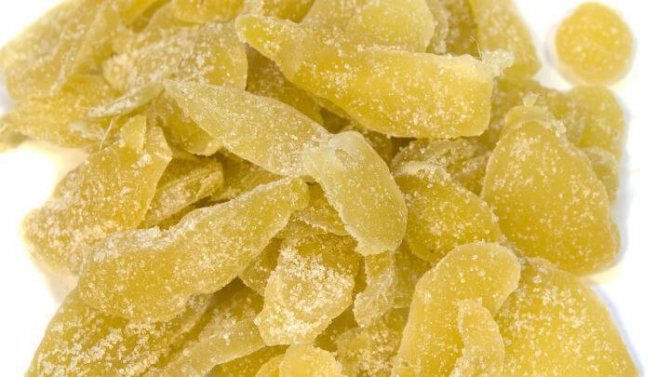

History of appearance and distribution
Ginger appeared on the European continent in the 9th-11th centuries. It was brought by Muslim conquerors to the southern part of Spain. The spice quickly gained popularity and began to be used for preparing meat and fish dishes. Every meal in a noble family was accompanied by the use of ginger seasoning. It was also added to expensive drinks.
Mass distribution in Europe was organized by the merchant-traveler Marco Polo. Today, the use of ginger is practiced in various fields of human activity. This is cosmetology, and cooking, and medicine.
Ginger root: benefits and harms
Ginger varieties differ from each other in the color of the rhizome pulp. It can be light, oily yellow, brownish, with bluish specks. The smell from the rhizome also has its own characteristics. But, it remains constant for all varieties sweetish pungent tastewhich essential oils give to the miracle roots.
The amazingly diverse composition of the plant, especially its rhizomes, made it an unsurpassed medicinal plant for all peoples of the world. Ginger root contains a large amount of pharmacologically active substances:
- Essential oils – 2–3,5%;
- Macronutrients - K, Ca, Mg, F;
- Trace elements - Mn, Cu, Zn, Co, Cr, Al, V, Se, Ni, Sr - 16.88, Pb, B, I; concentrate Fe, Zn, Se, Al;
- Lipids, starch, proteins, fiber;
- Vitamins C, B1, B2, B6, A, PP;
- Rare substances with antioxidant properties - fellandrin, citral, cineole, bornenone, gingerol, camphine. These substances are found in ginger essential oil. Gingerolamine gives the root a special burning taste;
- The most important amino acids - lysine, phenyalanine, methionine, etc.
The calorie content of ginger is 350 kcal per 100 g.
The beneficial properties of ginger help to restore immunity, improve digestion. It has found use in the treatment of many diseases.
Views and photos
There are several main varieties of ginger:
- Jamaican.
- Australian.
- African.
- Indian.
- Chinese.
- Pharmacy.
Jamaican
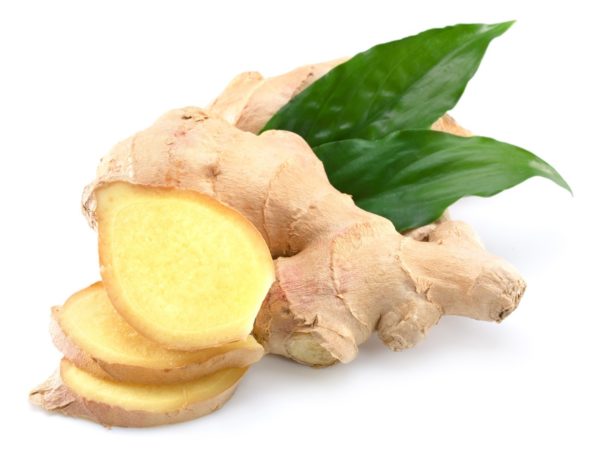

It is characterized by a fresh, delicate aroma, which is why such a root is used as an additional component in the creation of drinks and dishes. The roots are white. They are often brushed and then bleached with sulfuric acid.
Australian
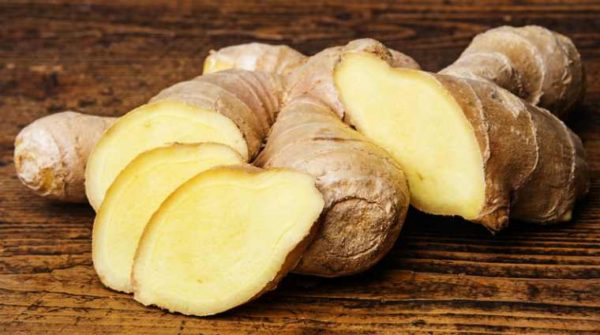

This variety has a characteristic lemon note in its aroma. She has a sweet taste, which is why she gained popularity in the confectionery industry.
African
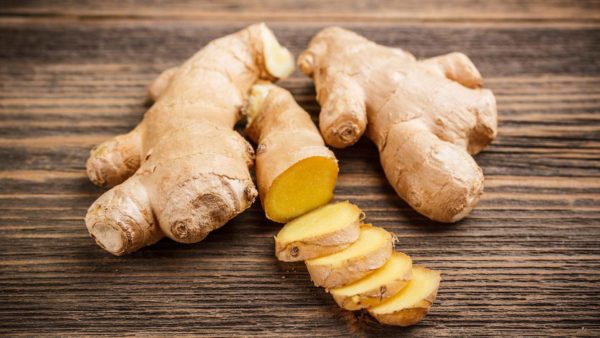

This ginger has a very persistent and sharp aroma, pungent taste. The main area of application can be considered perfumery. Aromatic oils are made from it.
Indian
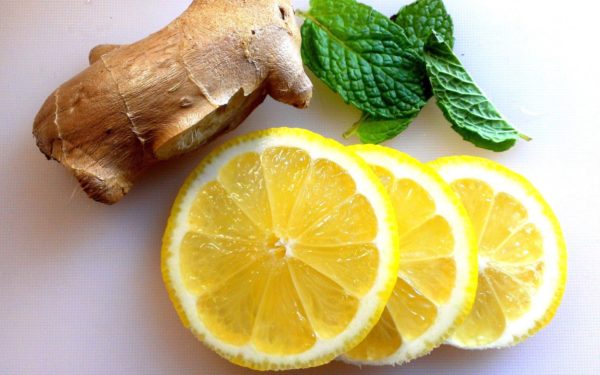

The Indian root has a lemon scent. It is used in the food industry around the world.
Chinese
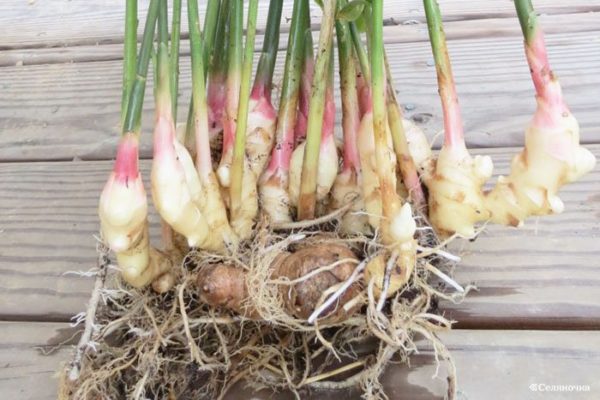

The Chinese variety has a high content of nitrogen dioxide. In some countries, it is prohibited to use it.
Pharmacy
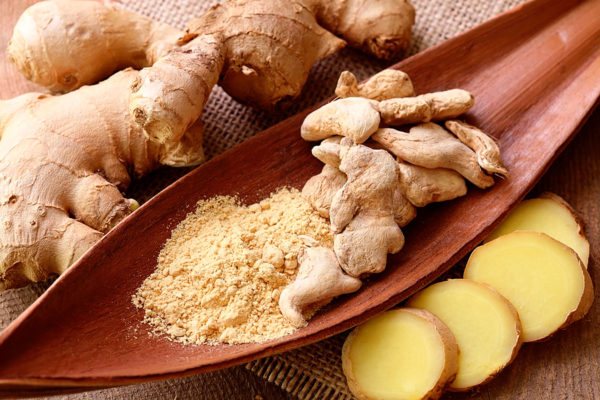

The pharmacy product has a pleasant smell and a burning aroma.Such a spice plant can be used dry, ground, whole, as well as in a candied state. Ginger extract is an alcoholic extract that contains volatile essential oils.
This variety is used in the culinary industry, in the confectionery industry. Sauces, liqueurs, beer and other drinks are made from it. Ginger oil is used to flavor foods. The root goes well with meat, fish, rice, potatoes, vegetables and chicken. It has a particularly good combination with pork, duck and mushrooms.
The healing properties of ginger
Treatment of colds
The beneficial properties of ginger are successfully used in the treatment of many diseases. For example, it is good to apply ginger for colds... Its antibacterial, antiseptic, expectorant properties are well-proven in the treatment of seasonal viral and colds.
It perfectly relieves symptoms such as runny nose, cough, sore throat. The simplest treatment is to take a ginger drink, most often tea. This tea should be taken 3-4 times in one cup during the day. Ginger for cough tea should be drunk in small sips. You can use ginger juice, infusion, broth, ginger essential oil.
Prevention and treatment of cardiovascular diseases
Ginger is used in the treatment of cardiovascular diseases. For example, it is believed to be useful for both high and low blood pressure. This raises the question - Does ginger raise or lower blood pressure?
It turns out that this amazing root normalizes blood pressure in both cases. Its use has a beneficial effect on the condition of hypertensive patients. In hypotonic patients, when taking ginger root, the muscle tone of the vessels increases, and the pressure rises from a low value to normal.
Ginger is also recommended for those whose blood pressure "jumps", then increasing, then sharply decreasing. Ginger, heats the blood, makes it less thick, saturates with oxygen. The peripheral vessels relax, their spasms are relieved and the patient's condition improves.
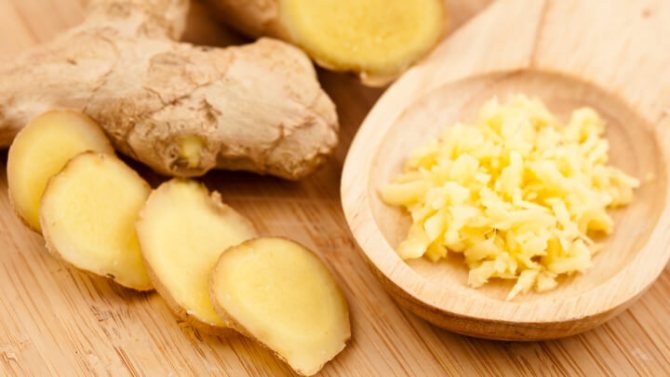

Use of ginger for diabetes
Ginger for type 2 diabetes is recommended for use because:
- Reduces blood sugar levels.
- It has anti-inflammatory and wound healing properties.
- Burns excess fat and reduces weight.
- Improves the digestion process.
- Eliminates cholesterol deposits in blood vessels.
The main advantage of ginger in diabetes mellitus is the normalization of carbohydrate and fat metabolism, which is very important in this disease. Therefore, in type 2 diabetes mellitus, ginger is very useful and is recommended by endocrinologists.
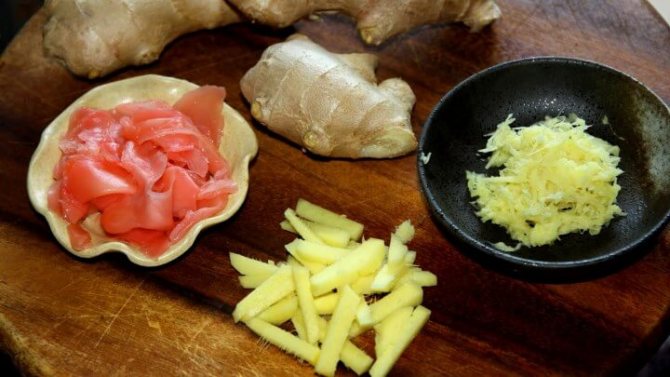

Strengthening the body's defenses
Due to its unique composition, it makes sense to use ginger for immunity. To increase the body's defenses after viral and colds, there is a wonderful recipe that includes ginger. it ginger with lemon and honey, recipe for health. Each of the three components of the recipe has its own special properties. Combined with each other, they provide an excellent immune recovery effect.
The health recipe has the following composition: ginger root - 400 g, lemon - 4 pcs., liquid honey - 200 g.
Rinse the lemons and cut into wedges. Peel the ginger and cut into small pieces. Pass the cooked lemons and ginger through a meat grinder, put in a glass jar and pour over with honey. Cover the resulting mixture and let it brew in a cool, dark place for 4–5 days.
You need to take the mixture daily for 1 tbsp. spoon half an hour before breakfast and drink one glass of water. EThis elixir of health cleans blood vessels, reduces weight, strengthens the body's defenses.
The use of ginger for cancer
The developments of American scientists have found that cancer cells can be affected by drugs based on ginger. The substance gingerol contained in ginger root acts on cancer cells and stops their development, and then reduces their growth.
Studies have proven the effectiveness of ginger root in stopping an already begun pathological process, and in some cases, its self-destruction.
Therefore, ginger is recommended by physicians as a prophylaxis for cancer, especially colon and rectal cancer.
Cancer patients undergoing severe chemotherapy may take ginger to relieve symptoms of nausea and vomiting.
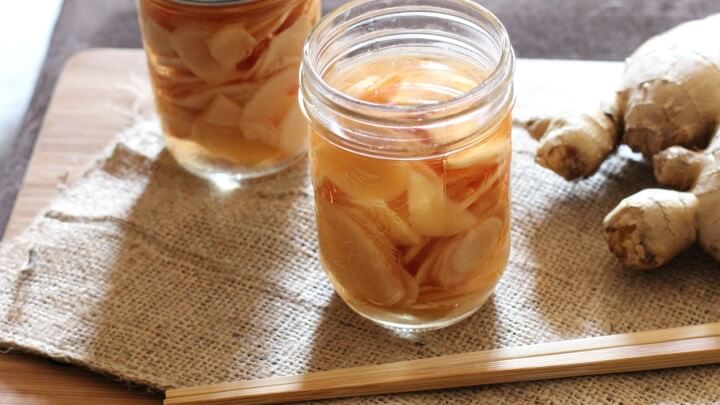

Treating certain eye conditions such as blepharitis
Washing the eyes with eye drops containing ginger juice helps relieve inflammation and allergies.
Studies conducted with ginger have shown that the beneficial properties of ginger have a pronounced medicinal focus:
- Anti-inflammatory and antibacterial;
- Antispasmodic (relieves spasms of blood vessels and improves their patency);
- Anti-sclerotic (cleans the walls of blood vessels, prevents the formation of blood clots);
- Cardiotonic (restores the tone of the heart muscle);
- Diaphoretic;
- Choleretic;
- Stimulates the digestive tract;
- Normalizes blood cholesterol levels, prevents its accumulation;
- General tonic and tonic (increases mental and physical performance, strengthens the body's defenses).
Gallery: ginger (25 photos)
Applying ginger root
Basically, ginger roots are used internally in the form of teas, infusions, decoctions, juice, diluted inlet, or tea. But there are other uses for ginger as well. For example, ginger juice is included in the stomach drops... In case of joint diseases, ginger root in the form of a paste is applied to the diseased joints, which helps relieve pain and swelling.
To relieve tension and stress, it is used ginger bath. Bath ginger can be used as a dry powder that is steeped in a little water and poured into the bath.
In home cosmetology, fresh ginger and in the form of a dry powder is used as part of masks and creams... In cosmetology, ginger is used for anti-cellulite massage, while it is used ginger oil... The properties of ginger oil should be examined in more detail.
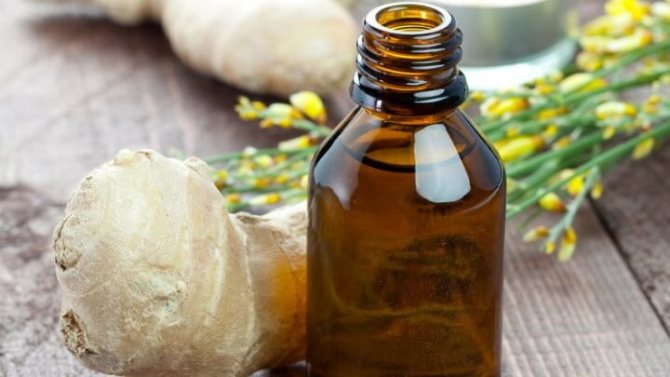

Ginger oil
Ginger Root Oil - Can be used as a seasoning and as a medicine. It combines the excellent qualities of a powerful antidepressant, an effective aphrodisiac and a real antiseptic.
There are two types of ginger oil:
- etheric (manufactured in an industrial environment),
- and directly ginger oil, which is obtained by mixing ginger extract with any vegetable oil.
Although both products are called oils, they have different chemical composition and medical indications for use. Indications for the use of essential ginger oil are:
- Violation of local blood circulation;
- Joint stiffness;
- Joint and muscle pain;
- Lack of appetite;
- Colds.
It is not recommended to use ginger essential oil in its pure form, as it is active and can cause an allergic reaction. It is mixed with any vegetable oil just before use. Regular ginger oil does not need to be diluted as it is less concentrated.
How to choose fresh ginger root in the store?
Description of the plant
Ginger flower can be decorative and medicinal, which is also used in cooking. The plant is native to places where the tropical climate prevails. Therefore, for comfort, it is necessary to provide high humidity and warmth.
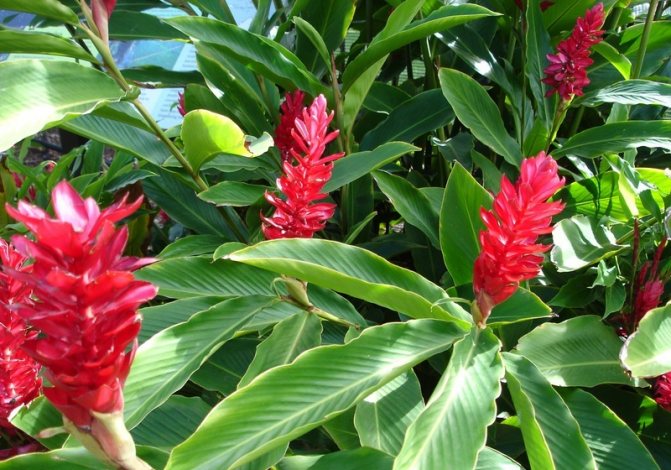

Ginger during flowering
Appearance
When discussing ginger, what it is, first of all, they remember its root, similar to Jerusalem artichoke. It is a tuberous plant that is often called an earthen pear. Many do not even think about what the ginger plant looks like.
Ornamental species are distinguished by more colorful flowering. Ginger, used in medicine and cooking, does not bloom so abundantly as to direct forces towards the formation of a powerful rhizome. The plant, due to its external resemblance, is compared to a reed. But his stem is not covered with scales.
Bloom
Ginger blooms in spring and summer, and at home it is extremely rare. With proper care and comfortable conditions, flowers appear in the third year of life. The color depends on the type of exotic representative of the flora. The most common shades:
- brown;
- orange-yellow;
- red.
What does a ginger plant look like:
- The inflorescences resemble ears formed at the top of the stem from leaves rolled into a tube. They can be monochromatic or combine several shades;
- The shape of the inflorescences is varied. They look like cones, lilies, peonies.
Note! The flowering period is accompanied by the spread of a sweet aroma. It can lead to allergic reactions. With the onset of cold weather, flowering ends.
Leaves
Leaves begin to grow at the root. They are narrow and reach a length of 20 centimeters, while the plant itself can grow up to two meters. At the ends, the leaves are pointed, have scales.
Root
The root of the plant is practically on the surface, in the upper layer of the soil. An underground stem covered with leaves is often confused with it. Inside, it is yellow and fleshy. The rhizome develops and releases ground stems. Leaves and inflorescences are subsequently formed on them.
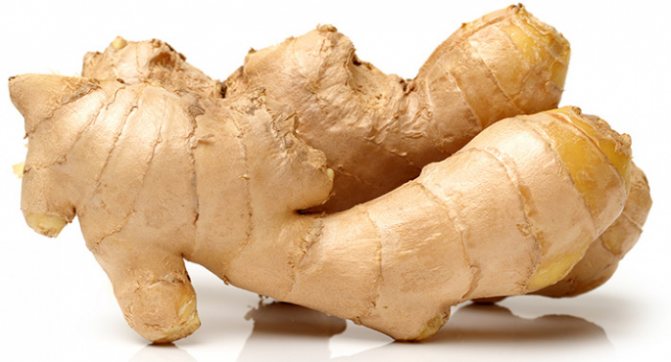

Root
The root has a spicy taste and sounds like ginger in English. The word has a different meaning - piquancy, which fully reflects the quality of the plant.
Contraindications for ginger
So, considering the question of whether ginger has beneficial properties and contraindications, it is easy to be convinced of its excellent medicinal qualities. But, Does ginger have contraindications? It turns out that it does.
- Do not take ginger during late pregnancy;
- Do not use ginger if you are breastfeeding a baby.
- Do not use ginger for exacerbation of gastrointestinal diseases (colitis, gastric ulcer and duodenal ulcer);
- It is forbidden to use ginger for cirrhosis of the liver and cholelithiasis;
- It is not recommended to use ginger masks and creams for skin diseases, since ginger has a pronounced local irritant effect, which can aggravate skin problems;
- You can not use ginger root in all forms for bleeding;
- Do not use ginger root at elevated temperatures, as the temperature may rise even higher;
- Ginger should be used with caution for cardiovascular diseases.
When deciding to take ginger as an adjunct treatment, you should consult with your doctor. There are medications that should not be taken with ginger root (eg, antiarrhythmics, blood pressure medications, blood sugar).
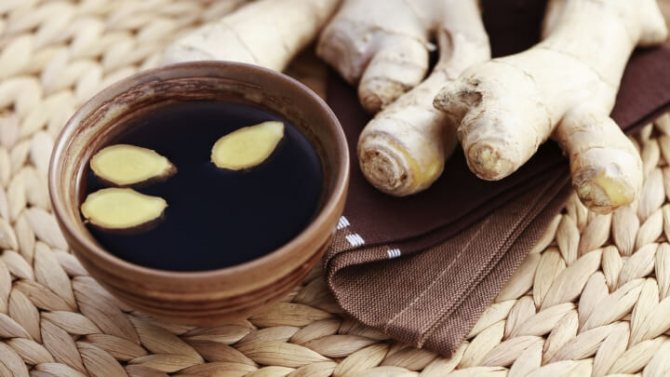

Care
- Once you have made the decision to grow ginger at home, it is important to provide it with proper care. If shoots appear on it, you can assume that you did not try in vain. It is worth noting that such a tropical plant is very whimsical. It needs constant warmth and high humidity.
- The plant pot should be placed on the south or southeast window. But it should not be exposed to direct sunlight. If you do not have this opportunity, you can provide the plant with light using artificial sources.
- In a warm and hot summer, it is worth taking the plant out to the balcony or into the yard if you live in a private sector. It should be placed in partial shade - so you can observe rapid growth and development.
- Watering should be moderate and the soil moist. Please note that the plant is very sensitive to spraying with water at room temperature.
- At an early stage of development, the plant needs feeding with organic and mineral fertilizers. Potassium is suitable to enhance growth, and phosphorus will stimulate flowering. Despite the active growth, at home, you can spend several years in order to grow a small plant.
- In winter, ginger enters a dormant state and its leaves dry up. During this period, it does not need watering. It is worth moving it to a cool room. Some even advise keeping the plant pot in the refrigerator.
How is ginger good for you?
The benefits of ginger for men
How is ginger good for men? Since ancient times, the glory of the root of life has been entrenched in this root.
Celery root: useful properties, recipes. - here is more useful information.
Ginger for men is a stimulant of vitality. It strengthens their cardiovascular system, lowers high blood pressure. But, the main quality of ginger root is elimination of male infertility and restoration of erectile function.
Ginger promotes the production of the male sex hormone testosterone, restores the tone of blood vessels in the genital area. Men who regularly consume ginger root reduce the risk of prostatitis. All this contributes to the strengthening of men's health.
How is ginger good for women?
The beneficial properties of ginger for women are primarily associated with weight loss... The fashion for weight loss forces women to use a variety of methods for this. As an excellent fat burner and digestive regulator, ginger promotes safe and effective weight loss.
In addition, regular intake of ginger root promotes removal of toxins from the bodythat trigger the aging process of the body. Ginger root contains antioxidants that slow down the aging process and the transformation of healthy cells into cancerous ones. These wonderful qualities of the root of life are increasingly attracting the attention of women.
You will be interested in this article - Fish oil: benefits and harms. How to use?
Preparing any recipe for a face mask that contains ginger is very simple. The root contains vitamins of beauty and youth - A, C and E. It can be used to prepare skin care products for the face, body and hair. For example, there are simple recipes for ginger face masks.
Ginger is also good for hair. With problems such as dandruff, hair loss, dull, weakened hair - ginger root will help to successfully cope. In this case, it is worth using root juice, which is applied with massage movements to the scalp. In order for the hair to become well-groomed and healthy, you can use masks that include ginger juice.
Dosage form
Despite the large number of ways to use ginger, the most effective is the use of tincture. To prepare it, you need to take 200 g of fresh root and peel it, then cut and throw into a 1 liter jar. It is necessary to fill in with 40% alcohol or water. The tincture is prepared for 2-3 weeks, periodically it is necessary to shake the contents. Then you need to strain the liquid. For taste, you can add 30 g of honey. It is necessary to use 5 g 2 times a day before meals.
It takes a long time to grow a medicinal plant using seeds. It is difficult to find a wild plant, so it is impossible to get good material for sowing. A tree that is massively grown does not produce viable seeds. The fruit is a tricuspid box in which about a dozen seeds ripen, they are round, contain a lot of brown essential oil.
Ginger is one of the most valuable and mysterious plants. It is considered a versatile medicine, the hottest spice and an effective way to preserve beauty and youth.
How to grow ginger like a business?
Ginger is often grown as a commercial crop. That is, it is possible to grow this culture for business. For this, they mainly use not personal plots, but greenhouses. Because in them it is best to regulate the conditions of humidity and temperature. Outdoors, there is no way to control conditions.
Ginger is grown in small boxes. At the same time, the costs of growing are small, but it is necessary to purchase boxes, spend money on watering, soil preparation, and fertilization. At the same time, there is no need to spend a lot of effort on care, due to the fact that the culture is unpretentious in terms of fertilization, weeding and pruning. It is enough to plant it correctly, water it on time, fertilize it, and maintain a constant temperature. The ginger will grow on its own quite well.
Before starting such a business, you need to find points of sale. Most often these are small retail chains, trays with vegetables, as well as shopping centers that sell food. Be prepared that you will need to submit products for examination in order to receive all the necessary documents, a certificate of product quality.
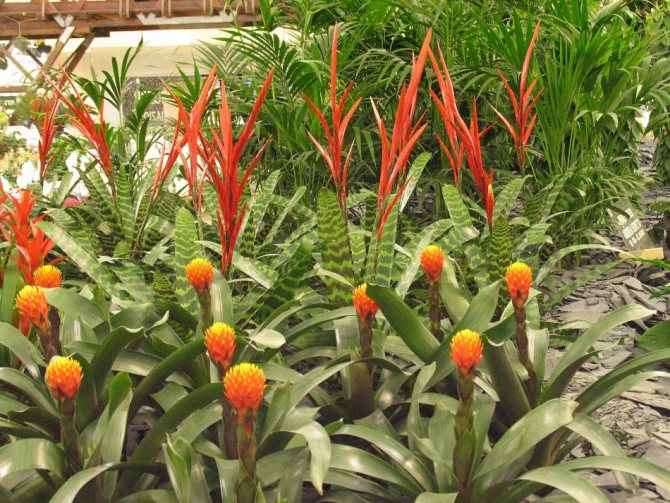

Ginger in the garden
Planting ginger root tubers: a step by step guide
After that, the buds will wake up on the root tuber and swell, it is planted in the ground. Step by step it looks like this:
- Large rhizomes are divided into parts. Each of the processes must necessarily have at least one large, viable kidney.
- The resulting sections are sprinkled with charcoal powder and allowed to dry.
- Delenki are planted to a depth of no more than 1-2 cm. They are simply laid out on the surface, and then sprinkled with a thin layer of soil.
The first shoots will appear no earlier than 2 weeks later. As soon as they grow to a height of several centimeters, they begin to apply fertilizers.
Is it possible to grow with us
Today, many are trying to grow ginger, and it turns out to be quite fruitful. The plant develops, but it is impossible to get a marketable root.
In flower pots
Summer residents plant a flower in pots, placing on the windowsills:
- For this, part of the root is placed in a plastic bag for germination.
- After the buds begin to hatch, the plant is placed in a pot.
- The root is planted in any fertile soil, deepening by 4 cm.
- Cover the top with foil with holes.
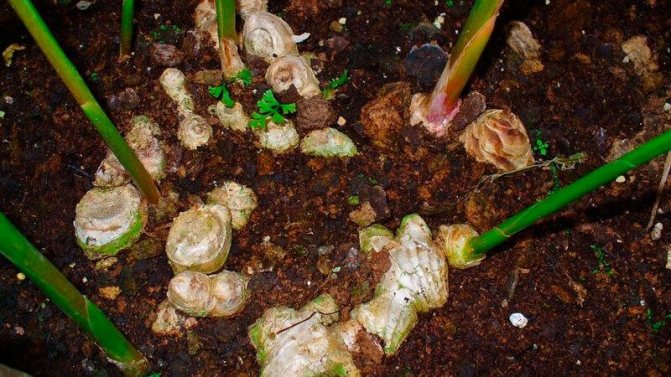

When shoots appear from the soil, the film is removed and the ginger is looked after, like other indoor plants.
Important! You can not put the pot in the sun, he loves partial shade.
Planting begins in February, when the warm summer season arrives, a pot of ginger can be placed under a tree in the garden. And with the onset of the autumn cold, bring it into the house and dig up the result.
Heated greenhouses
With the onset of the greenhouse season, the plant is planted in a greenhouse with heating. This should be done in early spring. The conditions of the heated room make it possible to extend the growing season until all the shoots emerge and dry out completely. An obligatory growth factor is the installation in the greenhouse of devices that maintain constant humidity. Growing ginger in these greenhouses is expensive.
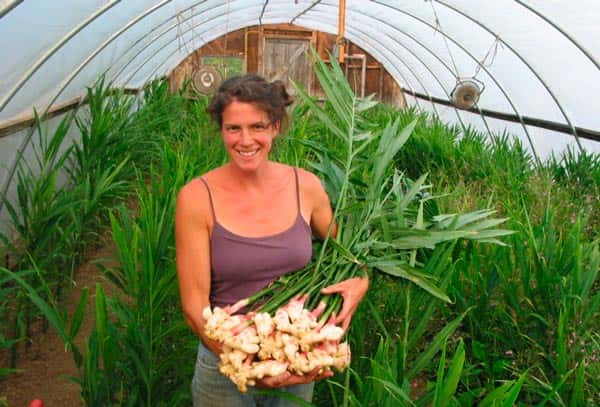

Combined method
The combined method involves the initial planting and growing of ginger in indoor conditions, and with the opening of the greenhouse season without heating, the plant is put under cover and grown until late autumn.
How to get and store fruits
The roots grow within 8-10 months and increase from the original size by 1.5-2 times. In a few years, if you don't dig them out, there will be much more of them. In terms of nutritional value, such fruits will be much better than store-bought ginger.The signal that it is time to harvest is yellowing and drying of the tips of the leaves, their falling apart in different directions. It is not necessary to dig up all the tubers at once, but only as needed. The mother plant is left to grow.
A week before harvesting, watering is completely stopped, rhizomes are removed from the soil, small roots are cut off. They need to be dried in the sun for several days. You can store the crop at a temperature of + 2..4 degrees for up to 3-4 months. The vegetable compartment of the refrigerator is suitable for this.
It is not necessary to dig up the roots for the winter. With dry leaves, the plant can remain in the pot until spring. When the first young shoots hatch, you need to return to the usual care typical for the growing season.
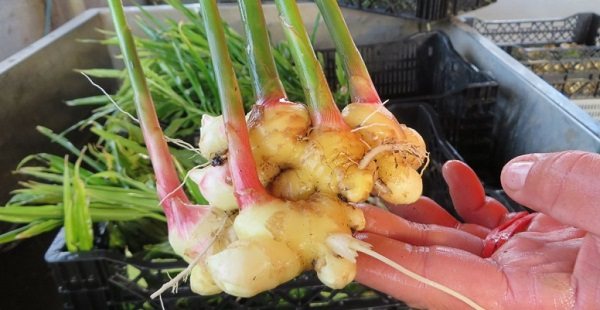

Location
When choosing a landing site (at home, on a site), one must remember that ginger belongs to heat-loving plants, tolerates heat well, but reacts negatively to direct sunlight and cold winds.
In a city apartment, it is useful to take out the pots on the veranda, balcony, and leave them in the garden. A good greenhouse makes it possible to get a good harvest of useful rhizomes. The optimum temperature for the rapid growth of ginger is considered to be about 25 °.
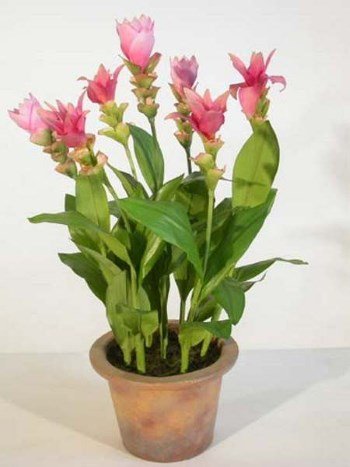

Ginger in a pot
Chemical composition
The chemical composition of the root includes about 400 nutrients and components. Here is a far from complete list of them:
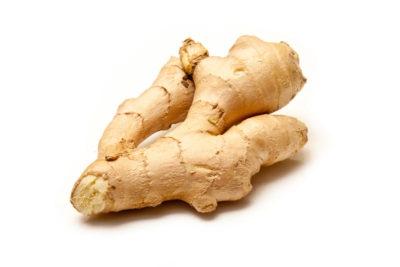

Magnesium.- Phosphorus.
- Calcium.
- Sodium.
- Iron.
- Zinc.
- Potassium.
- B vitamins.
- Vitamin A, E, K.
- Ascorbic acid.
- nicotinic acid and a number of other essential amino acids.
- Fatty acids Omega - 3 and Omega - 6.
- Active biochemical compounds:
- quercetin;
- ferulic acid;
- borneol;
- myrcene;
- gingerol;
- shogaol;
- retinol;
- thiamine;
- riboflavin.
Landing
When planting ginger, small, wide containers are used to obtain roots. The resulting rhizomes develop in them optimally. The plant rarely blooms, but a small pot helps to stimulate the appearance of inflorescences, limiting the growth of the rhizome. At the bottom of the pot, drainage is made from expanded clay. Soil is poured onto it. It consists of turf, sand, humus (1: 1: 1). Plants are transplanted into new soil every year.
Sprouted seedlings are planted in the greenhouse after the onset of warm days. Pre-germinated seedlings are recommended to be additionally covered with a film.
Planting a plant for growing at home is done at any time of the year, but in the spring (for example, at the beginning of March) the buds begin to awaken at the root, their growth is rapid. The roots are laid out in a pot, buds up, slightly pressed.
It is not necessary to sprinkle it with earth. Drizzle with warm water, cover with foil. Seedlings appear in three weeks.
The plant is considered friendly to grow together with other crops. In the open ground, neighboring pots on windowsills, greenhouses, flowers and vegetables grow well as neighbors, for example, cauliflower, leeks, garlic, varieties of Persian, Caucasian chamomile. Meeting the general requirements for growing conditions helps create wholesome plant compositions.
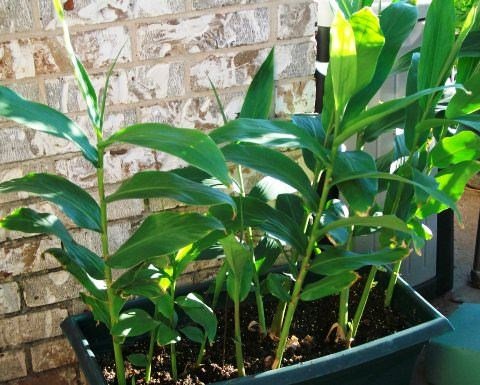

Plant in a wide container
Name
Ginger (Zingiber) is a herbaceous perennial of the Ginger family (Zingiberaceae).... It includes 1000 varieties. Among them is common ginger (pharmacy, suitable for human consumption). The name of the plant comes from the meaning of the word "singabera", meaning "horned". The mysterious shape of the roots resembles fairy-tale men.
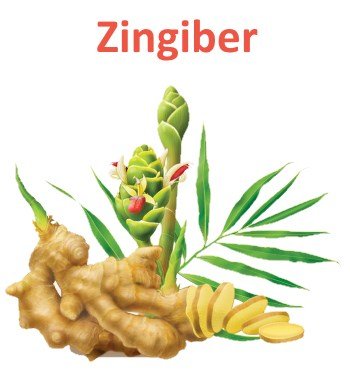

Zingiber
Reproduction
The easiest way to acquire a plant to obtain your own edible roots, flowers is considered to be growing from a part of the root with a dormant growth point. The horned root has branches with erect shoots that grow rapidly.
Almost all buds give new shoots suitable for plant propagation. It is much more difficult to get seedlings from seeds, especially since it is not always possible to acquire them.The advantage of seed reproduction of ginger is an increase in the likelihood, the rate of flower formation. This is of great importance for flower growers.
When growing ginger, it is recommended to use the root to obtain the roots. It is well stored and sold in supermarkets. Choose a root for planting according to the maximum number of eyes. It is carefully cut into pieces, the place of the cut is sprinkled with coal to protect it from rotting, the appearance of diseases.
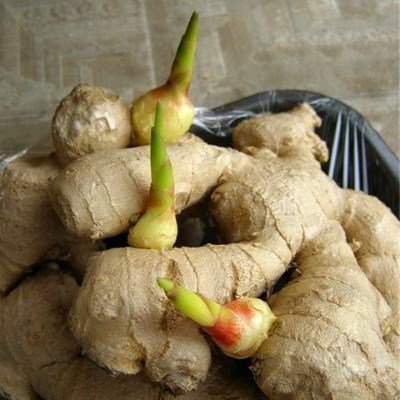

Root with buds
Pests, diseases
The plant is considered resistant to many pests, diseases inherent in house flowers, greenhouse plants. The danger is posed by a spider mite that feeds on plant sap. On the back of the leaf, the tick lays hundreds of small larvae.
The growth of leaves is inhibited, they dry up, the plant becomes pale, covered with yellow specks, and quickly dies. A preventive measure in the fight against spider mites is planting with the correct distance of plants from each other, loosening, disinfecting the soil.
Instead of insecticides, rubbing the leaves with alcohol, soap solution is often used.
Origin
South Asia is considered the birthplace of a perennial plant. The inhabitants of the northern regions of India were the first to use it for food. There are known recipes for drugs (in Vedic medicine) dating back to the third millennium BC. An ancient Chinese rite is known to dip bags of ginger into the grave of a deceased person. He protected the deceased from evil forces, allowing him to enter the afterlife. Navigators and merchants spread the expensive root to different countries.
The growing demand for ginger is met by the products of industrial plantations. They are found in Australia, China, India, West Africa, Barbados, Indonesia. The herbaceous plant can be grown in the climatic conditions of the middle zone in greenhouses, greenhouses, and at home.
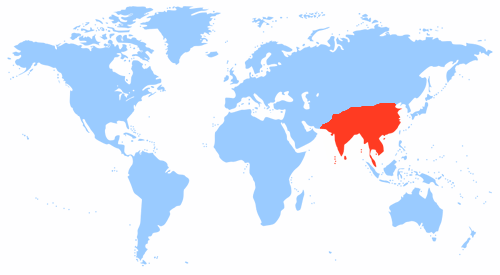

Homeland of the plant
How does the root grow?
So how does ginger grow? Seeing the long-awaited sprouts, change the plant care scheme. Frequent, 5 times per week, watering will ensure good growth of the shoots.
Temperature up to 25 degrees and the absence of drafts will give your pet a chance for successful development.
Mineral dressing Once a week and feeding with organic matter with a high potassium content will support the adaptation.
Important! Planting ginger is recommended in winter or early spring. The plant does not tolerate transplants well, therefore feeding is very important.
Ginger does not tolerate a drop in temperature to 15 degrees, it can be ruined by the lack of moisture. Do not allow the soil to dry out, if the sprouts die, the plant cannot be revived.

